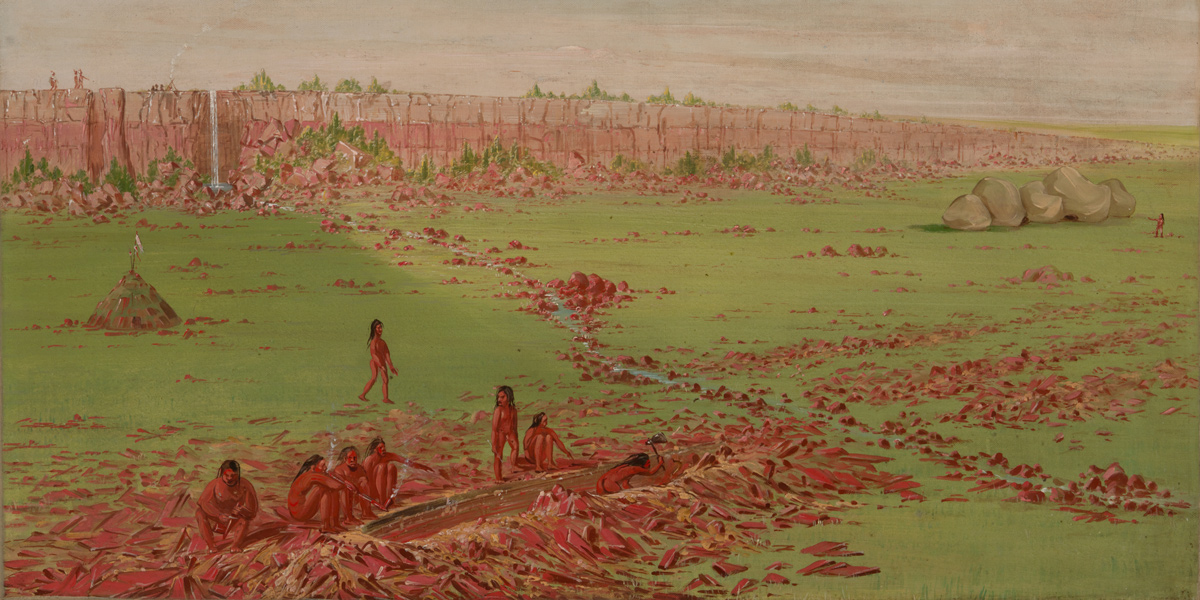Across from Ponca, NE Strong winds create blowing sands, the sail must be ‘reefed’ and the white pirogue needs ballast to stay on course. Pierre Dorion describes the geography of the Big Sioux country. The Osage delegation arranged by Lewis and Clark prior to heading up the Missouri in May 1804 heads home.
Blowing Sands
we proceded on verry well passed a large Sand bar on N. S. the wind blew so hard that we were oblidged to take a reefe in our Sail & the Sand blew So thick from the Sand bars that we could not see the channel far ahead
—John Ordway
White Pirogue Steering Problems
the white pearogue could hardly Sail for want of Ballass, we put in Several kegs of pork &.C.
—John Ordway
Pipestone Quarry on the Coteau des Prairies (1836-37)
George Catlin (1796-1872)
Oil on canvas. Smithsonian American Art Museum, 1985.66.337.
Dorion’s Description of Siouxland
[The Big Sioux] heads with the St. peters and is navagable 75 Leagues . . . . below the falls on the right a Creek coms in on which the red pipe Stone is percured, & in the praries about, a place of Peace with all nations.
—William Clark
Catlin’s Description of “Pipestone Quarry”
On the very top of this mound or ridge, we found the far-famed quarry or fountain of the Red Pipe, which is truly an anomaly in nature (PLATE 270 [see figure above]). The principal and most striking feature of this place, is a perpendicular wall of close-grained, compact quartz . . . . At the base of this wall there is a level prairie, of half a mile in width, running parallel to it; in any and all parts of which, the Indians procure the red stoue [stone] for their pipes, by digging through the soil and several slaty layers of the red stone, to the depth of four or five feet. From the very numerous marks of ancient and modern diggings or excavations, it would appear that this place has been for many centuries resorted to for the red stone; and from the great number of graves and remains of ancient fortifications in its vicinity, it would seem, as well as from their actual traditions, that the Indian tribes have long held this place in high superstitious estimation; and also that it bas been the resort of different tribes, who have made their regular pilgrimages here to renew their pipes.
“The Great Spirit at an ancient period, here called the Indian nations together, and standing on the precipice of the red pipe stone rock, broke from its wall a piece, and made a huge pipe by turning it in bis band, which he smoked over them, and to the North, the South, the East, and the West, and told them that this stone was red—that it was their flesh—that they must use it for their pipes of peace—that it belonged to them all, and that the war-club and scalping knife must not be raised on its ground. At the last whiff of his pipe his head went into a great cloud, and the whole surface of the rock for several miles was melted and glazed; two great ovens were opened beneath, and two women (guardian spirits of the place), entered them in a blaze of fire; and they are heard there yet (Tso-mec-cos-tee, and Tso-rne-cos-te-won-dee), answering to the invocations of the high priests or medicine-men, who consult them when they are visitors to this sacred place.”
It will be seen also, that within a few years past (and that, probably, by the instigation of the whites, who have told them that by keeping off other tribes, and manufacturing the pipes themselves, and trading them to other adjoining nations, they can acquire much influence and wealth), the Sioux have laid entire claim to this quarry; and as it is in the centre of their country, and they are more powerful than any other tribes, they are able successfully to prevent any access to it.[1]George Catlin, Letters and Notes on the Manners, Customs, and Condition of the North American Indians, 4th Ed. (New York: Wiley and Putnam, 1842), 2:164,167,201–02.
Ti tañga jiñga Village
passed a place in a Prarie on the L. S. where the Mahars [Omahas] had a Village formerly.
—William Clark
Osages Head Home
Philadelphia 21. August 1804.
Sir [Thomas Jefferson],
I have the honor to inform you that this day Capt. Chouteau [Pierre Chouteau] with the Chiefs of the Osage nation of Indians took their departure from this city for Pittsburgh, on their way to their own country.
We proceeded on our tour as far North as the city of New York, where we continued eight days.
During our journey the party enjoyed perfect health, and no untoward circumstance occurred to mar the pleasure of the natives, or to frustrate the object contemplated by government.
The principal villages and cities through which we passed, and individual citizens vied with each other in acts of hospitality and kindness and I am persuaded the impressions which have been made on the minds of the Indians are most favorable to the views and wishes of the Executive.
. . . . .
Hez: Rogers.
Notes
| ↑1 | George Catlin, Letters and Notes on the Manners, Customs, and Condition of the North American Indians, 4th Ed. (New York: Wiley and Putnam, 1842), 2:164,167,201–02. |
|---|---|
| ↑2 | Hezekiah Rogers to Thomas Jefferson, Founders Online, National Archives, founders.archives.gov/documents/Jefferson/01-44-02-0261 [Original source: The Papers of Thomas Jefferson, vol. 44, 1 July to 10 November 1804, ed. James P. McClure (Princeton: Princeton University Press, 2019) 275–276 including notes]; also in Letters of the Lewis and Clark Expedition with Related Documents: 1783–1854, 2nd ed., ed. Donald Jackson (Urbana: University of Illinois Press, 1978), 208. |

